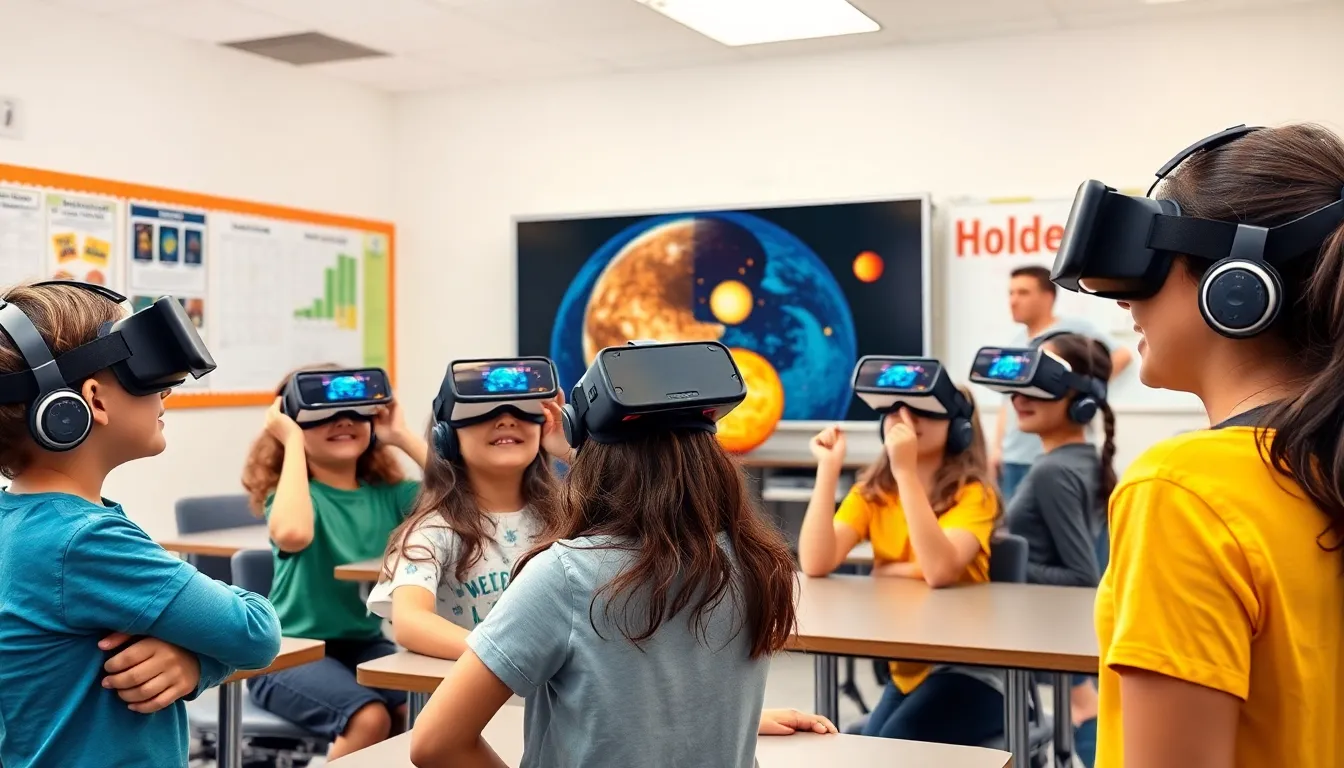In a world where smartphones are practically an extension of our arms, educational technology is evolving faster than a student can say “Wi-Fi.” From virtual classrooms to AI tutors, the latest trends are reshaping how students learn and teachers teach. Gone are the days of dusty chalkboards and outdated textbooks—now it’s all about interactive experiences and personalized learning journeys.
Table of Contents
ToggleOverview of Educational Technology
Educational technology encompasses tools and methods that facilitate learning and improve teaching. Innovations in this field significantly enhance student engagement and offer personalized learning paths. Virtual classrooms allow students to attend lessons from anywhere, breaking geographical barriers. AI tutors provide customized feedback, adjusting to individual learning styles for optimized support.
Interactive learning platforms incorporate gamification, making education more appealing and effective. Increased use of mobile devices enables access to resources on-the-go, catering to diverse learning preferences. Data analytics provide educators valuable insights into student performance, allowing for timely interventions.
Cloud-based resources promote collaboration among students and teachers, nurturing a community-centered learning environment. Accessibility features of modern educational tools ensure that all students, including those with disabilities, can participate fully.
Professional development for educators focuses on integrating technology in curricula, equipping them with essential skills. By embracing these advancements, institutions respond to the demands of a rapidly changing workforce and society. Enhanced communication tools facilitate interaction between educators, students, and parents, fostering a holistic educational experience.
Staying up-to-date with trends like augmented reality enriches students’ learning experiences by providing immersive simulations. The evolving landscape of educational technology continually shapes how knowledge is delivered and absorbed, paving the way for future innovations.
Recent Innovations

Recent innovations in educational technology continue to transform learning environments. These advancements contribute to more engaging and efficient educational experiences.
Artificial Intelligence in Education
Artificial intelligence plays a crucial role in modern classrooms. AI-driven platforms assist in personalizing learning experiences, adapting to each student’s progress. Educators utilize AI to provide targeted feedback and support. Learners benefit from intelligent tutoring systems that offer real-time assistance. Data reveals that institutions adopting AI tools report improved student performance and retention rates. Predictions estimate that AI’s role in education will expand, making it a central feature in future learning frameworks.
Virtual and Augmented Reality
Virtual and augmented reality have redefined classroom interactions. These technologies enhance immersive learning experiences, allowing students to explore complex concepts through simulations. Engaging virtual environments capture learners’ attention, making education more appealing. Schools implementing VR and AR experiences see increased enthusiasm among students. Research indicates that these technologies also promote collaboration and critical thinking skills. As accessibility grows, more educators incorporate VR and AR into their curricula, recognizing their potential to revolutionize how knowledge is absorbed.
Mobile Learning Solutions
Mobile learning solutions are gaining traction, empowering students to learn anytime, anywhere. These tools integrate seamlessly into daily routines, fostering continuous engagement.
Apps and Platforms
Numerous apps and platforms enhance mobile learning experiences. Popular platforms like Google Classroom, Microsoft Teams, and Zoom provide intuitive interfaces for collaboration. EdTech companies are developing specialized applications targeting various subjects, offering resources that cater to individual learning needs. These platforms often include features such as video conferencing, assignment submissions, and real-time feedback. User-friendly designs encourage participation, allowing more learners to engage actively with content.
Gamification Techniques
Gamification techniques enhance motivation among users, making learning enjoyable. Educators increasingly integrate elements like badges, leaderboards, and challenges to encourage progress. Research indicates that gamified learning increases retention rates and fosters a sense of achievement. Platforms applying gamification strategies promote healthy competition, keeping students engaged in their studies. By incorporating fun and interactive elements, educational experiences become more appealing, addressing diverse learning styles effectively.
Data-Driven Decision Making
Data-driven decision making represents a crucial shift in educational technology, focusing on leveraging student data to enhance learning outcomes. It empowers educators to make informed decisions based on concrete evidence.
Learning Analytics
Learning analytics encompasses the collection, analysis, and interpretation of data within educational contexts. Educators utilize these insights to identify trends in student engagement, understanding, and retention. Using tools to track these metrics enables a proactive approach to address learning gaps. Institutions that incorporate learning analytics see improved student satisfaction and achievement. By analyzing data over time, educators tailor instruction, allowing for individualized support. This targeted approach fosters a deeper understanding of learning patterns, ultimately benefiting both students and teachers.
Student Performance Tracking
Student performance tracking involves systematic monitoring of student academic progress. Educators employ various tools to assess individuals through assignments, quizzes, and participation. It’s crucial for identifying at-risk students early, facilitating timely interventions that boost performance. By tracking grades and engagement levels, educators can adjust teaching methods to better meet learner needs. Regular feedback helps students understand their strengths and weaknesses, promoting self-directed learning. Consequently, actionable insights gained from performance tracking lead to enhanced learning experiences and outcomes.
The landscape of educational technology is rapidly transforming, creating a more engaging and personalized learning experience. Innovations like AI tutors and virtual classrooms are redefining how students and educators interact with knowledge. As mobile learning solutions and gamification techniques continue to rise, they foster motivation and accessibility, making education more enjoyable.
Data-driven decision making is becoming essential, allowing educators to tailor instruction based on individual learning patterns. This proactive approach not only enhances student performance but also promotes self-directed learning. As these trends evolve, they pave the way for a future where technology and education work hand in hand to create dynamic learning environments. The ongoing integration of these tools will undoubtedly shape the future of education for years to come.




